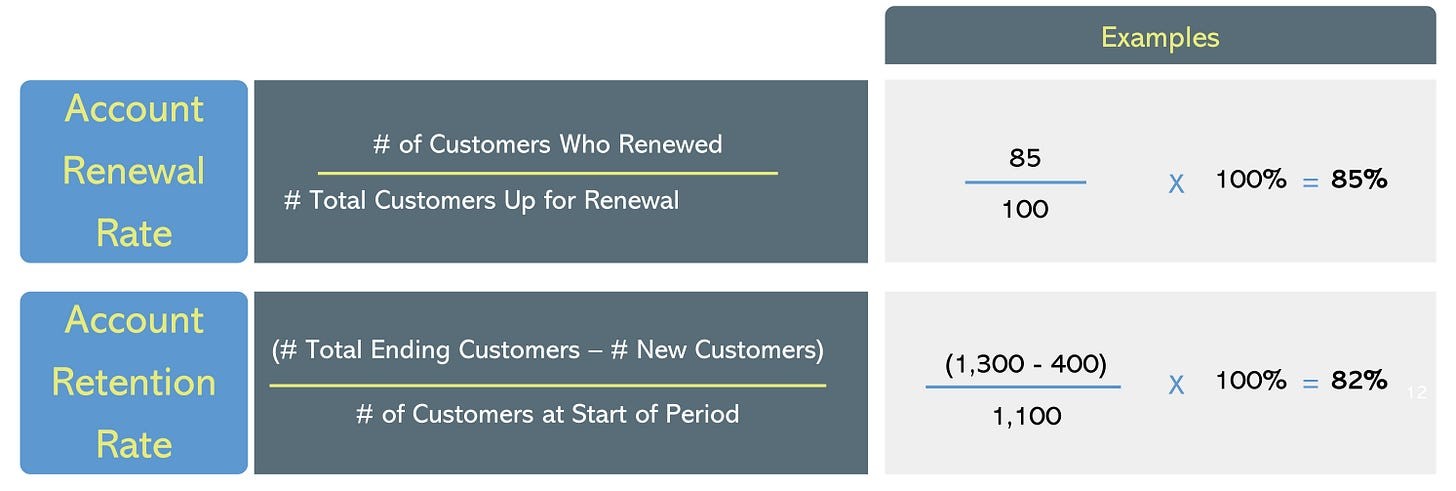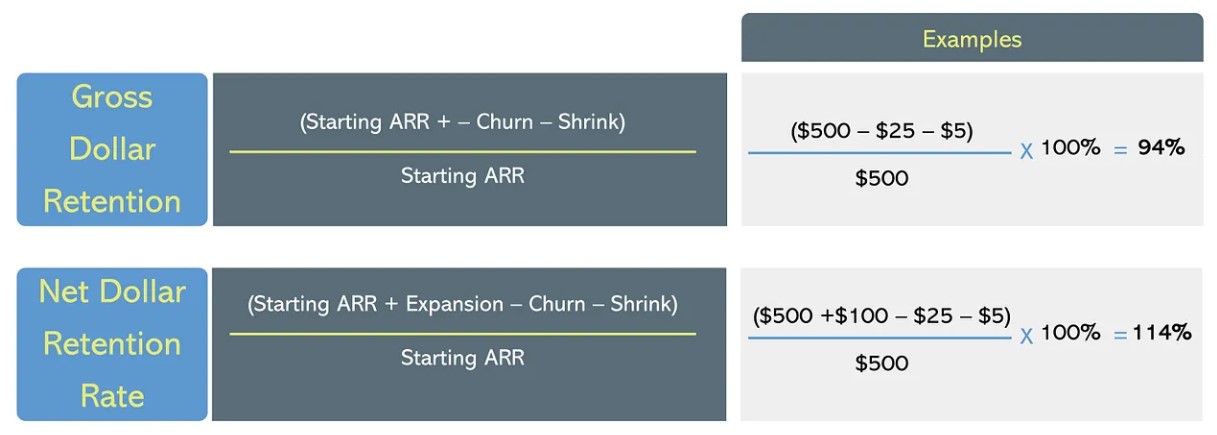The terms “Renewal” and “Retention” are throw around like “Affect” and “Effect”. Most people just 50/50 YOLO it when broadly referring to “keeping customers around.”
Today we’ll tackle four common points of confusion.
TL;DR:
- Renewal Rate vs Retention Rate: Renewal is based on Contract End Date, Retention is based on Contract Start Date
- Renewal Rate Land Mines: Beware of Pull Forwards to hit goals, over discounting, and comparability issues from period to period
- Dollar vs Account Measurement: Dollar rate is almost always higher than Account rate, as stickier, larger accounts subsidize smaller, fleeting accounts
- Gross vs Net Retention: Gross max is 100%. Net max is infinity. The difference is if you include expansion dollars or not
Thanks for reading Mostly metrics! Subscribe for free to receive new posts and support my work.
Renewal Rate vs Retention Rate
Renewal rate tells you how many customers re-signed at the end of their contract.
In practice that means listing out all the customers that renewed during a period, ignoring contract start date.
Renewal rate is a measure of how many of your customers at a specific end date said “Yes”.
Retention Rate is a little different. It measures how well you’re maintaining customers who signed up during the same time frame.
In other words, Renewal Rate is based on contract end dates and Retention Rate is based on contract start dates.
The other big difference is Renewal Rate is measuring only what’s up for Renewal, while Retention rate is looking at your whole customer base as long as they were on board as of a specific date. That means there are usually more accounts being measured in Retention formulas than Renewal formulas, since not all customers Renew on the same date.
Both views are useful. Typically Renewal rate is used more internally to keep a grip on month to month operations, while retention rate is more commonly used for investors externally. But once again, people inside and outside the business do care about both.

Renewal Rate Land Mines
Something else to watch out for – it’s totally possible for customers to Renew early. Let’s say the customer doesn’t expire until December. But the Sales Team may have a compelling event to Renew the contract in October. This is great in practice, because it de-risks the future. But there are three potential drawbacks:
- Sales teams may pull forward renewals just to beat their quotas in the current period – it’s like borrowing from tomorrow to pay for today. This can be a slippery slope if you get aggressive and over-mine your renewal base
- This problem is further exacerbated if sales teams are not only pulling forward renewals, but also overly discounting them to hit their number
- Furthermore, pull forwards overinflate your true renewal rate for the period. They can throw off false signals, as you are increasing both the numerator and denominator with a win on something that wasn’t truly up for renewal yet. Depending on the magnitude of pull forwards, this can make compares tough from period to period.
Dollar vs Account Retention
When looking at either Renewal or Retention rates, most of the time you’ll have a higher Dollar rate than Account rate.
Why is this? Well your larger accounts tend to be stickier. The contracts tend to be longer (multi year), the procurement cycles tend to be more thorough, it’s harder for a larger org to rip you out, and there’s less risk of an enterprise company going out of business.
Account based rates treat every account the same – regardless of if it’s a $10K or $500K account.
As you can see from the example below, the Dollar Renewal Rate is higher than the Account Renewal Rate, as the smaller accounts churning out are subsidized by larger accounts that are renewing.

Gross Retention vs Net Retention
Your max Gross Retention is 100%. Your max Net Retention is technically limitless.
Gross Retention is a measure of how well you keep the dollars you previously signed up on board. The only way to improve Gross Retention is to churn less.
Net Retention is a measure of how well you keep the dollars you previously signed up on board, plus any expansion. That expansion can come by way of selling them more products, more licenses, or increasing usage. And like Gross Retention, you can also improve Net Retention by churning less.

To simplify the math – the only difference in the formulas is the inclusion of expansion dollars or not.
It’s important to look at both Gross and Net Retention – an incredible expansion motion may mask a leaky bucket. But Gross Retention will punch you squarely in the face if customers are leaving.
Bringing It All Together
So which metric should you use? Ideally all of them. It’s more about how you apply them to the situations at hand. Different battles require different weapons. Also, I can’t believe I just wrote that.
Here’s one more hypothetical comparison using formulas to bring it all together. Takeaways include:
- Our Gross Dollar Retention is almost identical to Dollar Renewal Rate, meaning we are doing an equally good job keeping customers happy regardless of when they signed up or expired.
- Our Net Retention is above 100%, which means that we’d grow by 14% Y/Y without adding any new customers. More on Net Retention in this post.
- “Dollars leaving the building” is comprised of 83% churn (complete goodbye) vs 17% shrink (partial goodbye)

